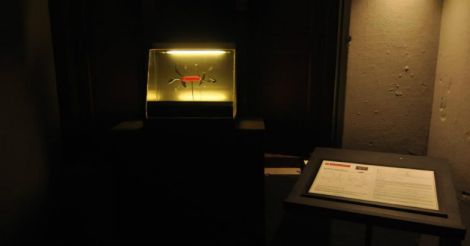Kochi: He pieced together Viagra and aspirin tablets to make rosaries — ubiquitous symbols of prayer, hope and divinity across civilisations — to portray the two dominant but conflicting strands of tradition and modernity, faith and market in contemporary India.
The intriguing artwork, part of his celebrated ‘Japmala’ (2008), heralded Biju Joze’s arrival on the art scene in a very impressive manner. He has once again come out with a signature performance at the ongoing Kochi Muziris Biennale (KMB) by fashioning out a multi-armed, weapon-wielding Hindu deity from the hybrid tools of iconic Swiss Army Knife.
‘Swistik Pocket Knife’, the artist’s work at Aspinwall House, incorporates into the compact body of a Swiss Army Knife weapons and other ritualistic tools from India. The ingenuity of the artwork lies in the fact that tools like can openers, screw drivers, scissors and nail clippers in an ordinary Swiss Knife have been creatively replaced by implements like ‘Trishul’ (trident), ‘Lavithram’ (Malayalam word for sickle), ‘Ankhusha’ (a mahout’s goad) and ‘Eeli’’ (coconut grater) to create the fascinating spectacle of a Hindu deity with several arms holding diverse weapons.
Tools like ‘trishul’ and ‘shulam’ (spear) are revered because of their religious symbolism. Others like ‘Pooga Kartarii’ (nut cracker) are functional but now falling into disuse in the face of superior technology. The ‘khukri’ (dagger) and ‘karavaalah’ (sword) are weapons that have been rendered obsolete.
“I had this plan of doing a work with various Indian tool/knife sets, which is altogether different in its significance and implications. A Swiss Army Knife has twelve sets of standard functional and non-functional tools – a large blade, a coconut/vegetable grater, an elephant goad, a trident, a small blade-like tiger claw incisor, an earwax scoop etc. I have restructured these tools into a non-functional object,” Joze said.
“The idea was to make a mechanized tool set with knives emerging out of the handle in a slow motion so that the viewer would not anticipate what was to emerge from it,” he explained.
In all his works, Joze tries to juxtapose materials and symbols, which are marked by hybridity and melding of cultures and artefacts. Swistik Pocket Knife, displayed in a plastic box on the wall, offers the various tools in shapes meant to evoke symbols from Indian mythology.
“It’s a mystery to note why the prayer beads are used in almost all major religious orders. It is also important to observe that in some instances even terminally-ill patient bypassed complicated surgeries and got healed from their illnesses through their belief and faith,” he said, adding: “A pocket knife is the reliable companion of a man — and increasingly of a woman.”
There is a subtle political tinge about most of his artworks. He has the ability to twist the mundane to produce a new object with multilayered connotations. It embodies his understanding of socio-cultural history which he juxtaposes with contemporariness — combining concept and material to complement and extend each other. It allows the art object to generate larger meanings and understanding for a viewer.
“This is one platform where one can witness various art forms,” said the 1972-born Joze, an alumnus of Maharaja Sayajirao University of Baroda and University of Ideas, Biella (Italy).
Jitish Kallat, curator of KMB’14, says, “Joze engages with the wave of transformations India is currently undergoing from the unique vantage point offered by the city of Bengaluru, the country’s premier IT hub and a gateway for global capital.”
Joze's work may appear working at two different levels with regard to form and structure, but there is always a dialogue between the two, which has been described by an art critic as ‘a visual condensation of a larger narrative or myth’. Like his artwork, the artist himself appears to be flitting between different roles of an activist and an observer.
About the legacy of the Biennale, Joze said, “The KMB is relatively new to India and one gets a chance to experience widely different kinds of contemporary works in our own country. I think such an experience itself is legacy in some way.”











































 Artist Biju Joze’s installation Swistik Pocket Knife at the Aspinwall House
Artist Biju Joze’s installation Swistik Pocket Knife at the Aspinwall House
Disclaimer
The comments posted here/below/in the given space are not on behalf of Manorama. The person posting the comment will be in sole ownership of its responsibility. According to the central government's IT rules, obscene or offensive statement made against a person, religion, community or nation is a punishable offense, and legal action would be taken against people who indulge in such activities.